SLA Antibodies: Their Role and Mechanism in Immunity
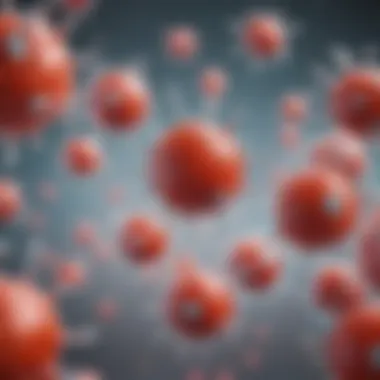
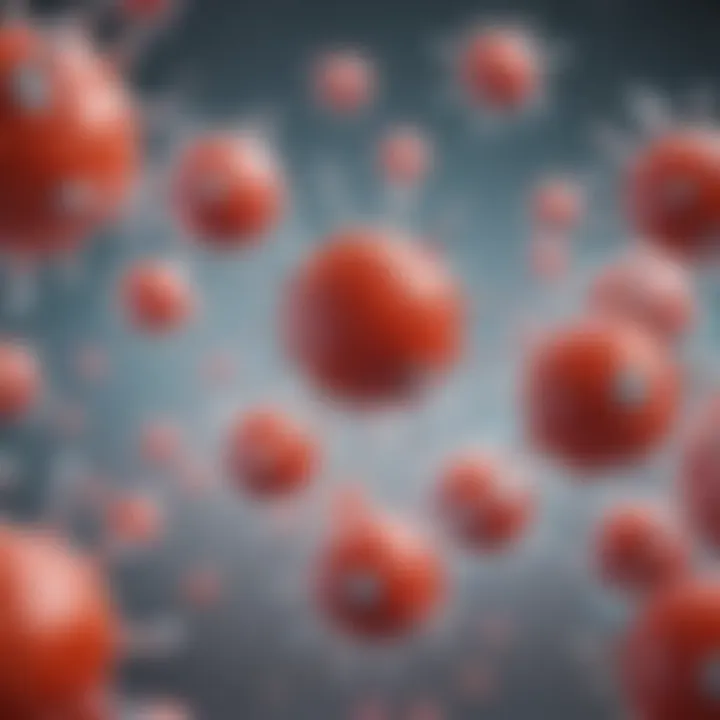
Intro
SLA antibodies occupy a vital space in the domain of immunology, significantly influencing how our body responds to various pathogens. Understanding their role requires peeling back layers of molecular complexity and appreciating their functional nuances. At their core, SLA antibodies embody a specialized immune response, bridging innate and adaptive immunity, and participating intricately in disease pathology. This multifaceted nature poses critical questions worth exploring, such as: How do these antibodies interact with specific proteins? What implications arise from their unique mechanisms?
Research Overview
Summary of Key Findings
The landscape of SLA antibodies is rich and complex. Recent studies indicate that these antibodies not only recognize but actively participate in the immune system's orchestration against pathogens. Key findings highlight their role in:
- Antigen recognition: SLA antibodies have a specialized ability to bind with certain antigens, facilitating targeted immune responses.
- Receptor interactions: Through interactions with various receptors, these antibodies modulate immune signaling pathways, affecting T-cell response and regulating inflammation.
- Pathophysiological implications: Abnormalities in SLA antibody levels can correlate with numerous autoimmune diseases, suggesting their potential as biomarkers or therapeutic targets.
SLA antibodies, by interacting with a variety of receptors, underscore the sophisticated communication strategy our immune systems employ to fend off disease.
Relevance to Current Scientific Discussions
The ongoing dialogue among researchers emphasizes the versatility of SLA antibodies in both disease prevention and therapeutic applications. Their increasing recognition in modern immunotherapy positions them as pivotal components in developing targeted treatments for autoimmune disorders and cancers. Discussions within the scientific community often center around:
- The challenge of harnessing SLA antibodies in treatments without triggering adverse immune responses.
- Novel approaches to enhance the specificity and efficacy of these antibodies in therapeutic contexts.
- The potential for these antibodies to serve as indicators for immunological health or disease progression.
Methodology
Research Design and Approach
Investigators typically approach the study of SLA antibodies through a blend of molecular biology techniques, ranging from structural analysis to functional assays. This multifaceted research design aims to elucidate both the structural intricacies and the functional capabilities of these antibodies in immune responses. For instance:
- Structural biology methods such as X-ray crystallography and cryo-electron microscopy help discern antibody structures at atomic resolution.
- Functional assays assess binding affinities and the biological effects of SLA antibodies on immune cell behavior.
Data Collection and Analysis Techniques
Data collection often employs cutting-edge techniques which provide insights into antibody behavior:
- High-throughput analysis can identify variants of SLA antibodies in patient samples, offering clues into their diversity and role.
- Advanced bioinformatics tools aid in interpreting complex datasets, revealing correlations between antibody reactivity and disease states.
This systematic approach not only enriches our understanding of SLA antibodies but also drives innovations in therapeutic strategies that harness their potential.
Through careful examination of these details, we not only grasp the vital role of SLA antibodies in immunological responses but also acknowledge their far-reaching implications in healthcare.
Intro to SLA Antibodies
The world of SLA antibodies is not merely an academic curiosity; it plays a pivotal role in the broader field of immunology. Understanding SLA antibodies is key to unraveling the intricate dynamics of immune responses. Their presence and functionality directly impact how organisms defend against pathogens, manage autoimmune disorders, and engage in cancer immunology. This section aims to highlight the significance of SLA antibodies, guiding readers through foundational concepts and the historical journey that shaped our current understanding.
Definition and Overview
SLA antibodies, or Specific Lymphocyte Antigen antibodies, are a specialized class of immunoglobulins that arise from the immune system's response to specific antigens. These antibodies are not just random players; they are tailored. Each SLA antibody has a specific target, binding to distinct structures on pathogens such as viruses, bacteria, or cancer cells, thereby initiating a cascade of immune responses.
These antibodies orchestrate a systematic approach to defending the body, functioning through various mechanisms. For example, they can neutralize pathogens directly, facilitate their destruction by other immune cells, or even activate complex signaling pathways that bolster the immune defense. Understanding these roles facilitates not only a better grasp of biological processes but also opens the door to innovative therapeutic strategies.
Historical Context and Discovery
The journey of discovering SLA antibodies is a narrative filled with significant milestones that changed the landscape of immunology. The groundwork for these antibodies was laid as researchers pieced together our understanding of the immune system in the early to mid-20th century. Notably, critical advancements were made during the identification of different antibody classes, which set the stage for the exploration of SLA antibodies.
In the 1950s, researchers began to unravel the complexities of lymphocyte function, revealing how certain antibodies were produced in response to specific antigens. Over the decades, a series of studies unveiled the detailed mechanisms behind SLA antibodies, shedding light on their structure and function in the immune response. This exploration continues to evolve, reflecting changes in scientific paradigms and technological advancements in molecular biology research.
"Understanding the history of SLA antibody research provides critical insights into its current and future applications in immunology."
This overview demonstrates how SLA antibodies are interwoven with various aspects of health and disease. Their identification, roles, and the ongoing research surrounding them are essential considerations for both academic inquiry and practical application in healthcare. As we delve deeper into the specific structural attributes and mechanisms of SLA antibodies in subsequent sections, we will uncover the profound impact these molecules have on immunological responses and their relevance in contemporary medical research.
Structural Biology of SLA Antibodies
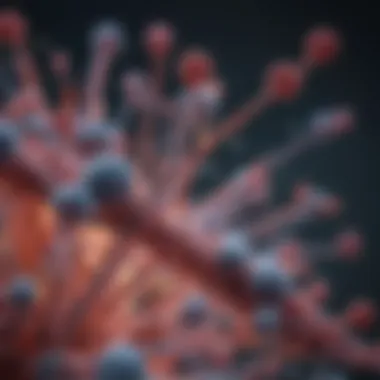

Understanding the structural biology of SLA antibodies is fundamental to grasping their functionality in immunological responses. Structural biology examines the molecular framework of these antibodies, offering insights into how their shapes and compositions directly affect their interactions with antigens. This section aims to highlight not just the biological aspects but also the implications of these structures in health and disease.
Molecular Composition
SLA antibodies, like all immunoglobulins, are complex proteins composed of chains of amino acids. Their backbone consists of heavy and light chains that form a Y-shaped structure. Each class of antibodies has a distinct composition that determines its function in the immune response. The variable regions at the tips of the Y shape are critical for binding specifically to antigens, allowing SLA antibodies to recognize and neutralize a vast array of pathogens.
The molecular composition can impact several key characteristics:
- Affinity: The strength of the antibody's binding to an antigen is largely determined by its molecular makeup. Changes in the sequence of amino acids can alter binding efficacy.
- Specificity: Different molecular structures allow for the recognition of various antigens, leading to tailored immune responses.
- Isotype Variation: SLA antibodies can exist in multiple isotypes (like IgG, IgM), each with unique functions dictated by their molecular structure. For instance, IgG has a longer half-life and provides lasting immunity, while IgM acts swiftly during the initial immune response.
Antigen Binding Sites
The antigen binding sites of SLA antibodies are crucial for their role in the immune system. These sites consist of hypervariable regions, also known as complementarity-determining regions (CDRs). Their configuration allows for specific and high-affinity interactions with antigens, making them a target for both pathogen recognition and therapeutic interventions.
Each binding site can be visualized as a lock-and-key mechanism, where the antibody is the lock and the antigen is the key. Factors influencing this interaction include:
- Shape complementarity: The physical compatibility of the antibody binding site and the antigen's structure is vital.
- Electrostatic forces: Charged regions on the binding site and antigen can enhance or diminish binding affinity.
- Hydrophobic interactions: Certain amino acids in the binding sites favor interactions with hydrophobic areas on the antigen, stabilizing the complex.
Thus, understanding antigen binding sites is pivotal for developing targeted therapies, improving the efficacy of SLA antibodies against specific pathogens.
Conformational States and Stability
SLA antibodies exist in various conformational states, determined by internal and external stimuli. These states can impact their stability and functional capability. Environmental factors such as pH, temperature, and ionic strength can induce conformational changes in the antibodies.
- Conformational Dynamics: The flexibility intrinsic to SLA antibodies allows them to adapt their shape in response to binding events. This adaptability is crucial for effective immune function.
- Stability Considerations: Stability is a double-edged sword; while it ensures the antibody retains its conformation to exert its function, it must also be pliable enough to adjust as needed. Techniques such as bioengineering are employed to enhance the stability of these antibodies without compromising their functionality.
"Examining the states of SLA antibodies unveils the intricate dance of structure and function, highlighting how even minor alterations can significantly impact their performance in immune responses."
In summary, the structural biology of SLA antibodies is a rich and complex field that directly correlates with their role in immunity. A detailed understanding of their molecular composition, antigen binding sites, and conformational dynamics not only broadens our knowledge but also paves the way for innovative therapeutic strategies.
SLA Antibodies and the Immune System
SLA antibodies play a pivotal role in the broader context of the immune system, acting as crucial players in recognizing and responding to pathogens. They are produced in reaction to various threats, like germs or even rogue cells. Understanding how these antibodies interact with the immune system can illuminate both their benefits and complexities in health and disease.
Synthesis and Production
The process of synthesizing SLA antibodies is a finely tuned mechanism that begins with B cells in the body. When a pathogen enters, these B lymphocytes identify foreign antigens and become activated. This activation spurs a series of cellular events leading to the proliferation of plasma cells, which are essentially antibody factories.
Typically, during an immune response, the B cells undergo somatic hypermutation. This process refines the affinity of the antibodies for the antigens, making them ever more effective in binding to and neutralizing threats. This selective refinement can be thought of as a form of biological trial and error, honing in on the best possible binding partners for eradication of pathogens.
Additionally, memory B cells form during this phase. They ensure long-lasting immunity by recalling previous infections. This is why individuals often experience a quicker recovery when re-exposed to familiar pathogens.
Mechanisms of Action
Once synthesized, SLA antibodies embark on a multifaceted journey within the immune landscape. Their primary role involves antigen binding, where they latch onto specific pathogens or infected cells. This binding can neutralize pathogens directly or mark them for destruction by other immune cells, such as macrophages.
The following are key actions that highlight the mechanism of SLA antibodies:
- Opsonization: This process enhances the likelihood that the immune system will identify and consume the pathogen. SLA antibodies coat the invaders, making them more recognizable to immune cells.
- Activation of Complement System: Once bound, SLA antibodies can trigger a cascade that leads to cell lysis and inflammation. This adds another layer of defense against infections.
- Neutralization: By binding to viral particles, these antibodies can prevent them from entering host cells, thus thwarting the infection right at the entry point.
These interactions illustrate the strategic importance of SLA antibodies in orchestrating a defense system that is both robust and adaptive.
Role in Antigen Recognition
Recognizing antigens is a key factor in the immune response. SLA antibodies achieve this through their unique binding sites that are specific to particular antigens. This specificity allows the immune system to discern between self and non-self, a crucial distinction that guards against autoimmune reactions.
Moreover, the structural diversity within the SLA antibody family means it can recognize a plethora of antigens from various pathogens.
To summarize key points:
- Diversity: The repertoire of SLA antibodies includes numerous unique binding sites, enhancing pathogen recognition.
- Affinity Maturation: Through an evolutionary process, antibodies improve their ability to bind target antigens, increasing effectiveness.
- Input for Adaptive Immunity: SLA antibody interactions contribute vital information to T cells, which further strengthens the immune response.
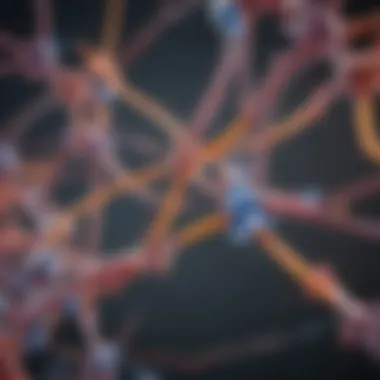
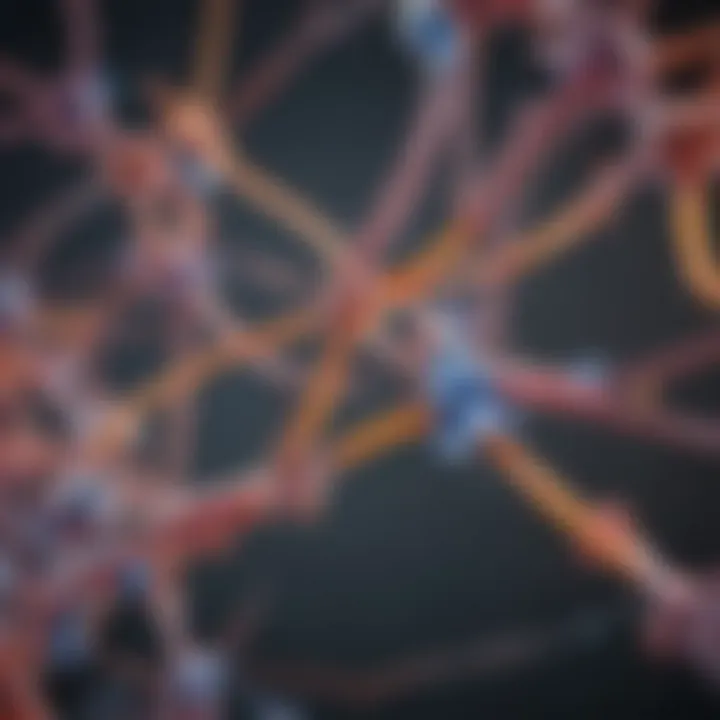
"The ability of SLA antibodies to recognize and neutralize diverse pathogens is what positions them as critical components of adaptive immunity."
SLA Antibodies in Health and Disease
SLA antibodies play a pivotal role in the delicate equilibrium of immune responses, a balance that can tip toward either health or disease. Understanding these antibodies in the context of health and disease unveils crucial insights into various pathophysiological conditions. The implications for therapy and diagnostics are profound, as a clear grasp of SLA antibody mechanisms can lead researchers to better strategies for combating illnesses.
Infectious Diseases
SLA antibodies have surfaced as a significant player in the realm of infectious diseases. These antibodies contribute to the immune defense by identifying foreign invaders, such as bacteria and viruses, enabling timely responses. When these invaders make their way into the body, SLA antibodies can bind to their antigens, which triggers a cascade of immune reactions.
- Neutralization of Pathogens: The binding of SLA antibodies to the pathogens neutralizes their effect, thus preventing them from causing further harm.
- Activation of Complement System: They also initiate the complement system, a crucial part of the immune response that enhances the ability to clear infections.
In many cases, the presence of SLA antibodies can be indicative of a thriving immune response. For example, in viral infections such as HIV, the antibody levels can inform the progression of the disease and help guide treatment decisions. Conversely, the absence or underperformance of these antibodies may coincide with chronic infections, revealing a compromised immune surveillance system.
Autoimmune Disorders
In stark contrast to their role in fighting infections, SLA antibodies can also contribute to autoimmune disorders. Here, the immune system malfunctions, recognizing self-antigens as foreign. This misidentification can lead to a range of conditions, where body tissues are attacked by the very antibodies meant to protect them.
- Mechanisms of Autoimmunity: The interplay between SLA antibodies and self-antigens can result in conditions like lupus or rheumatoid arthritis, where inflammation and tissue damage ensue.
- Biomarkers for Early Detection: Elevated levels of specific SLA antibodies often serve as biomarkers, enabling the early detection of these disorders and allowing for timely intervention.
Understanding the mechanisms driving autoimmunity is essential for developing effective therapies, as it can direct specific treatment modalities aimed at modulating the immune response.
Cancer Immunology
The landscape of cancer immunology offers yet another critical aspect of SLA antibodies. These antibodies can be instrumental in identifying tumoral antigens, harnessing the body's immune response against malignant cells.
- Tumor Antigen Recognition: SLA antibodies can be tailored to recognize tumor-associated antigens, promoting the immune system to launch an attack on cancer cells.
- Therapeutic Applications: This principle underlies many therapies being explored in oncology, where monoclonal antibodies are designed to selectively target malignancies.
Moreover, the study of SLA antibodies provides insights into tumor microenvironments. The presence or absence of these antibodies can influence tumor progression and help predict treatment efficacy, allowing for a step closer to personalized therapeutic approaches.
Applications of SLA Antibodies
The applications of SLA antibodies present an immense potential in both diagnostics and therapeutics, capturing the interest of researchers and healthcare professionals alike. These antibodies play pivotal roles in understanding diseases at a molecular level while offering innovative solutions for treatment. The following sections delve into the various dimensions of SLA antibodies, breaking down their specific applications that underline their importance in clinical and laboratory settings.
Diagnostic Tools
SLA antibodies are becoming instrumental in diagnostic practices, helping to identify and monitor a range of conditions. Their specificity allows for the detection of particular antigens associated with various diseases, leading to more precise and timely diagnoses. For example, in the realm of infectious diseases, tests utilizing SLA antibodies can pinpoint pathogens by recognizing their unique surface markers. This specificity not only enhances diagnostic accuracy but also reduces the likelihood of false-positive results.
- Competitive Advantage: Utilizing SLA antibodies in diagnostics can streamline testing processes, allowing for quicker results.
- Broader Applications: They are vital in contexts such as autoimmune disorder diagnosis, where differentiating between similar conditions can be challenging without specific markers.
- Examples of Diagnostic Tests: Commonly used tests include enzyme-linked immunosorbent assays (ELISA) and Western blotting, which often incorporate SLA antibodies for identifying specific proteins in patient samples.
It’s essential to recognize how advancements in SLA antibody technology lead to improved diagnostic tools, thereby enhancing patient outcomes in clinical settings.
Therapeutic Potential
The therapeutic applications of SLA antibodies are a rapidly evolving area that holds promise for various medical treatments. These antibodies can be harnessed to neutralize pathogens, inhibit destructive immune responses, or even modulate the immune system's behavior. Their therapeutic potential is supported by robust research indicating their efficacy in treating diseases like cancer and autoimmune disorders.
- Monoclonal Antibodies: One of the most significant developments in therapy using SLA antibodies has been in the creation of monoclonal antibodies. These therapeutics are engineered to target specific antigens, allowing for tailored treatment options that can significantly improve patient prognosis.
- Application in Cancer Treatment: For instance, SLA antibodies can be used to direct immune responses toward tumor cells, effectively highlighting and eliminating them. Such approaches are becoming standard in oncological therapies.
- Autoimmune and Chronic Conditions: In autoimmune diseases, SLA antibodies can sometimes be designed to block the activation of harmful immune cells, providing relief from symptoms and slowing disease progression.
Monoclonal Antibody Development
The development of monoclonal antibodies from SLA antibodies represents a cornerstone of modern immunotherapy. This process enables the creation of highly specific therapeutic agents capable of targeting particular disease mechanisms. Monoclonal antibodies have transformed treatment landscapes in various conditions, representing a leap forward in both effectiveness and personalization of care.
- Process of Development: Monoclonal antibody production usually involves the fusion of immune cells with myeloma cells to create hybridomas that can consistently produce the desired antibody. This method ensures a steady supply of high-affinity therapeutic antibodies, which are fine-tuned for specific antigens.
- Innovation in Treatments: Novel approaches in monoclonal antibody development have expanded opportunities, not just in cancer treatment, but also in treating infectious diseases and autoimmune conditions.
- Regulatory Landscape: Understanding the regulatory frameworks that govern the clinical use of monoclonal antibodies is crucial as well. This ensures that therapies are both effective and safe for public use, underscoring the importance of robust testing in preclinical stages.
In summation, the applications of SLA antibodies are leading the charge in advancing diagnostic and therapeutic approaches across medicine. Their specificity and effectiveness position them as invaluable tools in the ongoing battle against diseases, pushing the boundaries of what is possible in patient care.
Challenges in SLA Antibody Research
Despite the significant advancements made in understanding SLA antibodies, several challenges remain that necessitate further inquiry and innovative approaches. These hurdles can impact research outcomes, clinical applications, and the overall effectiveness of therapeutic interventions. Acknowledging and addressing these challenges is pivotal for the future of SLA antibody studies.
Technical Limitations


Researching SLA antibodies is intertwined with various technical challenges. Firstly, the heterogeneity of antibody populations makes it tough for scientists to isolate and study specific strands. For instance, traditional techniques may not capture the full spectrum of antibody variability, leading to incomplete data.
Moreover, the availability of reagents and specific tools that are finely tuned to SLA antibodies are often limited. In many labs, researchers are forced to adapt existing tools for different models, which may not give the precision needed. Some critical assays yield inconsistent results that can mislead findings. This presents a conundrum; without the right technical arsenal, researchers grapple to make definitive conclusions about SLA antibodies’ roles in immune responses.
Interpreting Complex Data
Once data is generated from experiments, the next hurdle often arises in the interpretation phase. SLA antibody research tends to produce massive datasets that require sophisticated analytical methods. The complexity of these data can cause confusion, potentially skewing insights gained from experiments.
For example, researcher may find correlations between antibody presence and disease outcomes but struggle to establish a direct causal link due to overlapping variables. Bioinformatics tools have become critical, but not all researchers are proficient in this area, leading to varied levels of understanding among teams.
In addition, differing methodologies employed across various studies can complicate direct comparisons. If one team's data suggests one trend, but another team’s approach yields contradictory results, it can sow seeds of doubt rather than clarity. Thus, harmonizing methodologies and establishing standardized data interpretation frameworks becomes essential.
Ethical Considerations
With the rise of SLA antibody research, ethical considerations have come to the forefront, particularly in the realms of animal testing and clinical trials. SLA antibodies, like any biologic agent, raise questions about their ethical use, especially regarding the potential harm to test subjects. Researchers must balance the pursuit of scientific knowledge with a responsibility to minimize suffering.
In addition, the prospect of marketing any resulting therapies introduces ethical obligations pertaining to patient consent and the transparency of benefits versus risks. Researchers also grapple with how findings might influence policy, especially with respect to vulnerable populations that may face barriers to accessing emergent therapies.
Overall, navigating these ethical landscapes is paramount. The legacy of SLA antibody research will be determined not just by its scientific merit but also by the ethical framework guiding its practices.
"As research in SLA antibodies progresses, it is imperative that both scientific advancement and ethical integrity walk hand in hand."
Future Directions in SLA Antibody Research
The rapidly advancing field of SLA antibody research is pivotal for developing new diagnostic and therapeutic strategies. Understanding the future directions can not only aid in refining our knowledge of SLA antibodies but also highlight their potential implications in varied health contexts. Researchers are zeroing in on how these antibodies can be utilized more effectively in fighting diseases, allowing for more tailored approaches that account for genetic variation and disease complexity.
Innovations in Therapeutics
Innovations in therapeutics concerning SLA antibodies are shaping the future landscape of treatment methodologies. For instance, new engineering techniques are being explored to enhance the affinity and specificity of these antibodies. One such innovation includes the optimization of antibody formats like single-domain antibodies. They can navigate the immune system more effectively than traditional formats, allowing targeted therapy with less off-target effects.
Moreover, combining SLA antibodies with cutting-edge delivery systems, such as nanoparticles, is emerging. Delivering these antibodies directly to affected tissues helps reduce potential systemic side effects while enhancing therapeutic efficacy. This targeted approach not only optimizes drug delivery but also improves patient outcomes.
Another exciting area is the exploration of bispecific antibodies—ones that can bind two different antigens at once. Applying this to SLA antibodies offers the potential to enhance their activity by simultaneously engaging multiple pathways in immune responses, which could revolutionize treatment for complex diseases like cancer.
"The integration of nanoparticle technology with SLA antibodies marks a notable shift toward personalized therapies that are both more effective and less harmful to patients."
Expanding Diagnostic Applications
The potential of SLA antibodies in expanding diagnostic applications cannot be overstated. Some researchers are currently investigating their role as biomarkers for various diseases. This is crucial as an early detection can be the difference between a manageable disease state and a critical condition. Traditional diagnostic methodologies often fall short; here, SLA antibodies could provide a more sensitive and specific alternative.
Additionally, utilizing high-throughput screening techniques can unlock new avenues for discovering novel SLA-related biomarkers. By characterizing these antibodies in various conditions, researchers can create rapid diagnostic tests that could, for example, determine the presence of autoimmune disorders or infectious diseases right from a patient’s blood sample.
Furthermore, there is a good deal of interest in how digital technologies, including machine learning algorithms, can analyze complex data from SLA antibody interactions quickly. This provides an opportunity to design personalized diagnostic tools that cater to individual profiles, paving the way for more accurate and timely interventions.
Personalized Medicine Approaches
Personalized medicine is gaining traction, especially given the complexities associated with individual immune responses. The integration of SLA antibodies into personalized treatments offers a unique opportunity to customize therapies based on patient-specific factors. By analyzing a patient’s unique antibody profile, clinicians can predict their response to certain therapies, tailoring interventions that maximize efficacy and minimize side effects.
Moreover, ongoing research is focusing on how genetic variations affect SLA antibody responses. Understanding these differences means that healthcare providers can modify treatment plans, ensuring that every patient receives optimal care suited to their genetic background. This could prove especially beneficial in treating chronic diseases that vary widely in their manifestations among different individuals.
The use of patient-derived xenografts is another promising approach. By injecting human tissue into immunodeficient mice, researchers can study how SLA antibodies interact with actual patient tissues. This could open up exciting new perspectives on how to enhance treatments based on real-time data, resulting in personalized strategies that frequently adapt to each patient's needs.
The incredible adaptability of SLA antibodies offers the scientific community the chance to ensure that future therapeutic approaches are informed, effective, and uniquely suited to health care’s growing demands.
Closure
The exploration of SLA antibodies sheds light on their pivotal role in our immune system, revealing intricate mechanisms that govern their operation. This conclusion serves not merely as an end note but rather as a cornerstone, emphasizing the importance of understanding these molecules in the wider context of immunology.
Summary of Key Insights
- SLA antibodies are crucial players in the immune response, aiding in the recognition and neutralization of pathogens. Their ability to adapt and bind to diverse antigens showcases their versatility and essential role in health.
- The structural nuances of SLA antibodies, such as their antigen binding sites, define their efficacy and specificity. Understanding these features offers a glimpse into their potential therapeutic applications.
- As science progresses, the applications of SLA antibodies extend beyond diagnostics and treatment, highlighting the importance of continued research in this arena.
"Advancements in SLA antibody research can lead to breakthroughs in immunotherapy and personalized medicine, substantially improving patient outcomes."
Implications for Future Research
- Innovative Therapeutics: There’s a burgeoning potential for new treatment modalities based on SLA antibodies, specifically in targeted therapies that could revolutionize how autoimmune diseases and cancers are managed.
- Evolution of Diagnostic Tools: As researchers understand the mechanisms at play, there could be an increase in precision diagnostics, allowing for more accurate disease detection and monitoring.
- Personalized Medicine Approaches: With a focus on genetic and molecular profiles, future studies might pave the way for tailor-made therapies that enhance treatment effectiveness by considering individual variability in antibody response.



